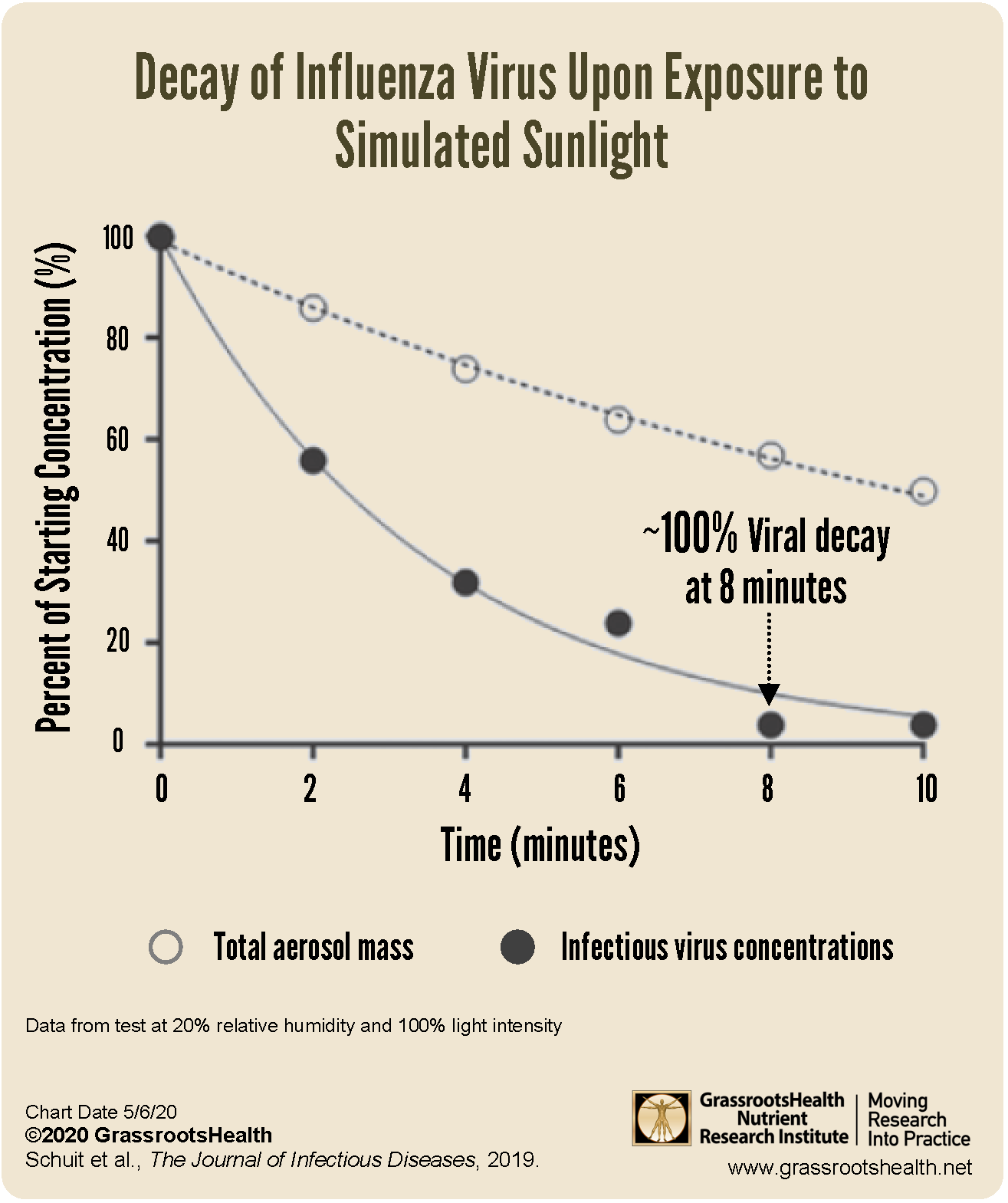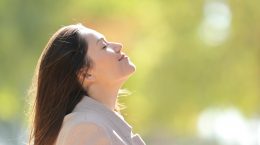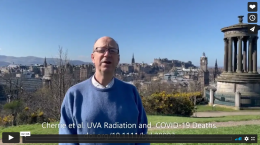Published on May 26, 2023
A review of studies demonstrate the multiple effects exposure to sunshine has on immune health and viral transmission
Key Points
- Vitamin D, produced upon exposure to UVB from sunshine, has demonstrated anti-infective, anti-inflammatory, and immunomodulatory properties, and influences approximately 2000 genes, many of which have to do with immune cell function
- Nitric oxide, released upon exposure to UVA, plays a key role in immunity, cellular function, neurotransmission, and also has antimicrobial and anticancer effects
- Several studies reviewed provide evidence that increased sunlight may not only help reduce the risk of severe viral infections, but it may also be an effective disinfectant for influenza, SARS-CoV-2 and other viruses

Exposure to sunshine can have profound impacts on immune health. Vitamin D, produced upon exposure to UVB from sunshine, plays a key role in the expression of our genes, especially those affecting immune health, DNA repair, cancer, and more. Nitric oxide, released upon exposure to UVA, plays a key role in immunity, cellular function, neurotransmission, and also has antimicrobial and anticancer effects. UV exposure (and vitamin D itself) can have a healthy, regulatory effect on the microbiome of the skin and the gut, helping to maintain the diversity of the microbiome, which in turn can stimulate anti-inflammatory and immunosuppressive pathways affecting immune health.
Below are several studies that further explain the relationship between sunshine exposure and immune health.
Vitamin D (from Sunshine & Supplements) Regulates Immune Function
Vitamin D has demonstrated anti-infective, anti-inflammatory, and immunomodulatory properties. It is known to affect the immune response in several important ways, specifically against viral infections. Multiple studies have linked vitamin D deficiency to increased severity and death due to COVID-19; a review of these studies can be found here.
Vitamin D influences approximately 2000 genes (and possibly more!), many of which have to do with immune cell function. These effects were demonstrated in a study by Holick et al., which enrolled 30 healthy individuals to take either 600, 4000 or 10,000 IU of vitamin D per day for 6 months. The authors then measured gene expression in white blood cells to determine if there were differences triggered by higher intakes of vitamin D. A significant “dose-dependent” effect was observed for gene expression at all levels of vitamin D intake, meaning the higher the dose the more genes that were affected.
This study also demonstrated how a deficiency in vitamin D can result in a less effective immune response.
Effects of Sunshine on Immune Function and COVID-19
Below are several studies that included the effects of sunlight specifically on COVID-19 outcomes.
Mukherjee et al. completed a meta-analysis to validate the relationship between low vitamin D levels and increased COVID-19 infection. They then used meteorological data to demonstrate the negative association between daily COVID-19 cases and temperature, UV Index, and cloud-free vitamin D UV doses, and concluded that “The findings of this study suggest that low UV exposure can affect the required production of vitamin D in the body, which substantially influences the dynamics of COVID-19 transmission and severity.”
A review by Gorman and Weller suggests that UV exposure may reduce viability of the SARS-CoV-2 virus, its rates of infection and replication, as well as disease severity, and that these effects are due to different wavelengths of light from sunshine. A positive association between higher ambient UV levels and lower rates of COVID-19 death was seen in most of the studies reviewed, along with a relationship between a higher UV Index and lower rates of death from COVID-19, which could be explained by more UVB induced vitamin D production with the higher UV Index.
Non-UVB Sunlight Exposure and Risk of COVID-19 Death
To look at the effects of UVA specifically, Cherrie et al. investigated the association between UVA exposure and death due to COVID-19 in particular areas of the United States, England and Italy. The authors only looked at data from locations that were experiencing a “vitamin D winter” – where UVB levels were too low to produce a significant amount of vitamin D during the time of the study – to reduce the potential confounding effect of vitamin D on the COVID-19 outcomes.
Daily average UVA exposure during the study time varied between countries. When comparing UVA exposure to the COVID-19 mortality rates within each area studied, a reduction in mortality rate ratio (MRR) of 0.71 was seen for every 100 KJ/m2 increase in UVA in the US, a reduction of 0.81 in Italy, and a reduction of 0.49 in England. Overall, when all three countries were combined, there was a mortality rate ratio reduction of 0.68 for every 100 KJ/m2 increase in UVA, with a predicted decrease in average risk of death by 1/3 to 1/2 from the lowest level of UVA to the highest level in each country. In other words, increased sunlight (specifically non-UVB in this study) was related to a much lower risk of death due to COVID-19.
The authors of this study conclude that “optimizing sun exposure may be a possible public health intervention” independent of vitamin D… and, it’s free!
Sunshine Can Reduce Viral Transmission
Sunshine can also help prevent the spread of viral infections. UVB, UVA, and violet rays from sunshine have been shown to inactivate many viruses, including influenza and SARS-CoV-2, however, the time it takes for each to do so varies based on latitude, season, and time of day.
A study by Schuit et al. showed the impact of simulated sunlight on aerosol transmission of the influenza virus, demonstrating an inverse relationship between simulated sunlight intensity and transmission of the influenza virus over long distances, regardless of humidity. This experimental study demonstrated nearly 100% viral decay after only 8 minutes of exposure to simulated sunlight, with a decay rate (of influenza virus) 13-times higher for sunlight compared to darkness.
Dr. Marc Sorenson, founder of the Sunlight Institute, commented on the Schuit et al. study, saying “The information from that simple paper is astounding… A decay rate (of influenza virus) 13-times higher for sunlight vs darkness is remarkable. It means instead of isolating at home, we need to either get out in the midday sunshine or get in a sunbed… Sunlight is the best disinfectant.” He continues by saying, “This is a beautiful thing, because internally, vitamin D can shut down the cytokine storm (inflammatory immune response), and externally, sunlight can cleanse the air. A great one-two punch.”
Several other studies have demonstrated the solar-sensitivity of the SARS-CoV-2 virus. Biasin et al. found that the amount of SARS-Cov-2 virus in the sputum of COVID-19 patients can be completely inactivated by UVA and UVB wavelengths, blocking infectivity. While the dose of each wavelength varied, UVC (which does not reach the earth’s surface but can be used through devices), UVB, UVA, and violet light all resulted in viral inactivation over time.
Ratnesar-Shumate et al. demonstrated that UVB irradiance and suspension matrix had a significant effect on the inactivation rate of SARS-CoV-2; the inactivation rate of the virus was much faster at the medium and high UVB levels vs the lowest. Based on analysis, ninety percent of the infectious virus would have been lost every 6.8, 8.0, and 12.8 minutes for high, medium, and low levels of UVB irradiance when in saliva, and 14.3 and 17.6 minutes for high and medium UVB irradiance when in the gMEM matrix.
Nicastro et al. also showed that UVA and UVB photons have powerful virucidal effects against the SARS-CoV-2 virus and other single-stranded RNA viruses. In particular, they found that “the Solar radiation that reaches temperate regions of the Earth at noon during summers, is sufficient to inactivate 63% of virions in open-space concentrations… in less than 2 min.” The authors describe the amount of time needed to inactivate the virus at noon for each degree of latitude during different months of the year, with a much greater monthly variation at the higher latitudes (representing seasonality).
A study by Rendell et al. looked at the ability of UV radiation in the United Kingdom to inactivate the SARS-CoV-2 virus. The authors found that, while certain months (April and May of 2020) did have higher amounts of UV available with the potential to have a significant impact (at least 90% viral inactivation), for 50-60% of the year (most of October through March) solar UV was not likely to have a significant impact – another representation of seasonality.
Overall, these studies provide evidence that increased sunlight may not only help reduce the risk of severe viral infections, but it may also be an effective disinfectant for SARS-CoV-2 and other viruses.
Make Sure You Are Getting Enough of Both Sunshine & Vitamin D
It is important to incorporate safe, sensible sun exposure into a regular routine, just as it is important to make sure you are getting enough vitamin D. Because the sun produces many health-benefiting molecules in addition to vitamin D, sunshine exposure cannot be replaced with taking a supplement.
It is also important not to stop supplementing with vitamin D during the summer. Most people do not make enough vitamin D from sunshine alone, due to their lifestyle and other factors, and therefore must rely on supplementation to maintain optimal vitamin D levels of 40-60 ng/ml (100-150 nmol/L).
This Sunshine Month, get 10% off your home blood spot test kits PLUS the free Sunshine eBook when using the code SUNMONTH24 at checkout.
Measure Your Vitamin D Level Today
 Having and maintaining healthy vitamin D levels and other nutrient levels can help improve your health now and for your future. Choose which additional nutrients to measure, such as your omega-3s and essential minerals including magnesium and zinc, by creating your custom home test kit today. Take steps to improve the status of each of these measurements to benefit your overall health. With measurement you can then determine how much is needed and steps to achieve your goals. You can also track your own intakes, symptoms and results to see what works best for YOU.
Having and maintaining healthy vitamin D levels and other nutrient levels can help improve your health now and for your future. Choose which additional nutrients to measure, such as your omega-3s and essential minerals including magnesium and zinc, by creating your custom home test kit today. Take steps to improve the status of each of these measurements to benefit your overall health. With measurement you can then determine how much is needed and steps to achieve your goals. You can also track your own intakes, symptoms and results to see what works best for YOU.
Enroll in D*action and Test Your Levels Today!






